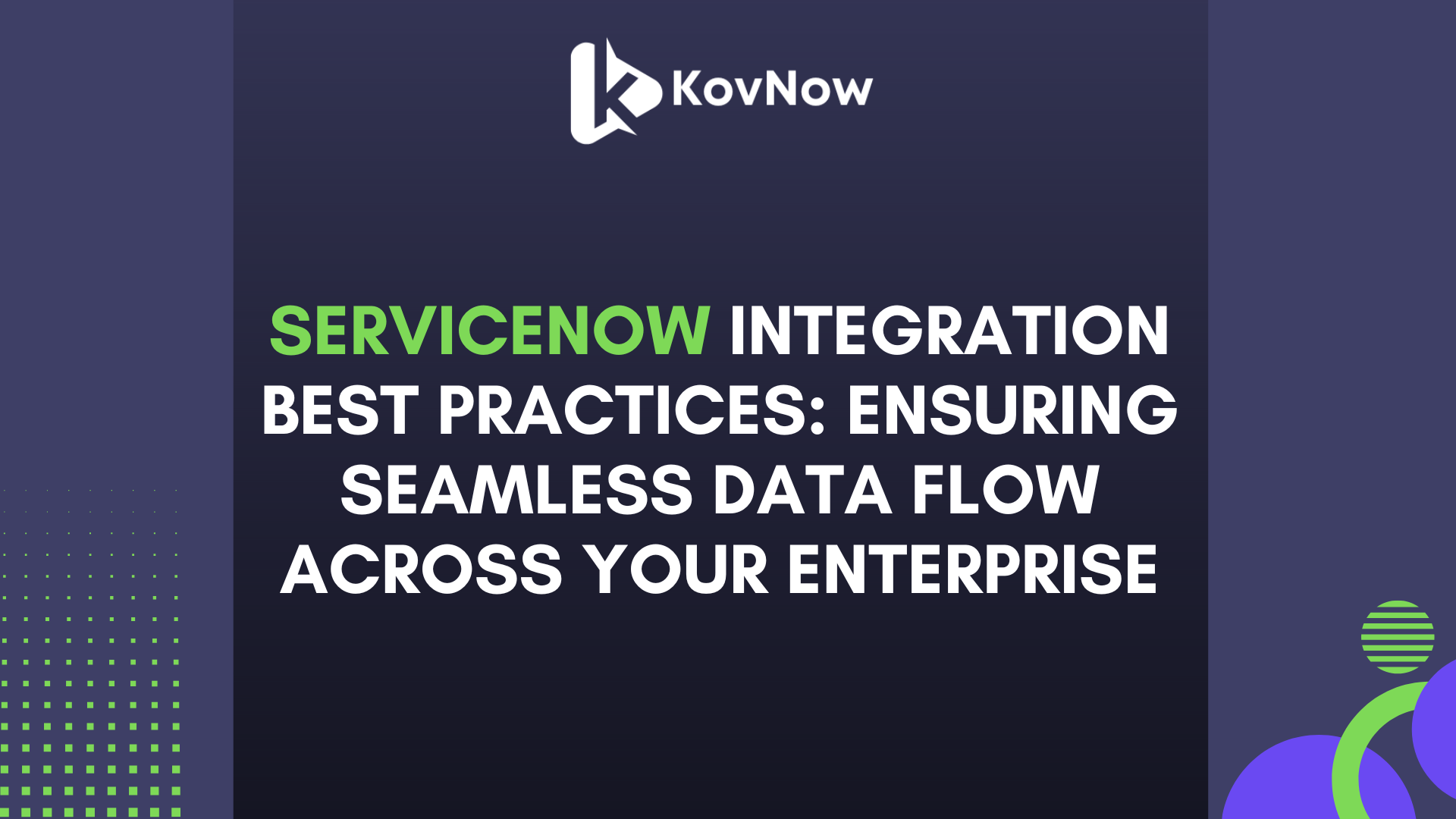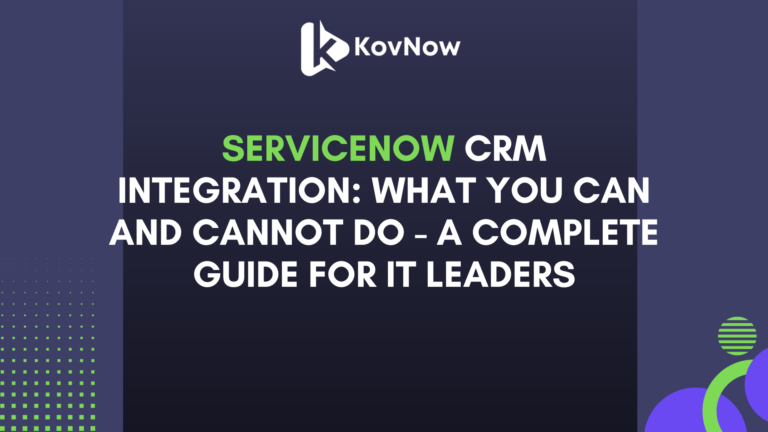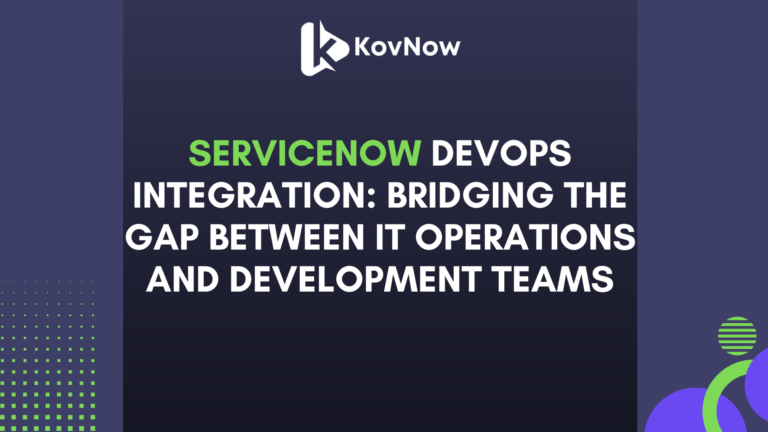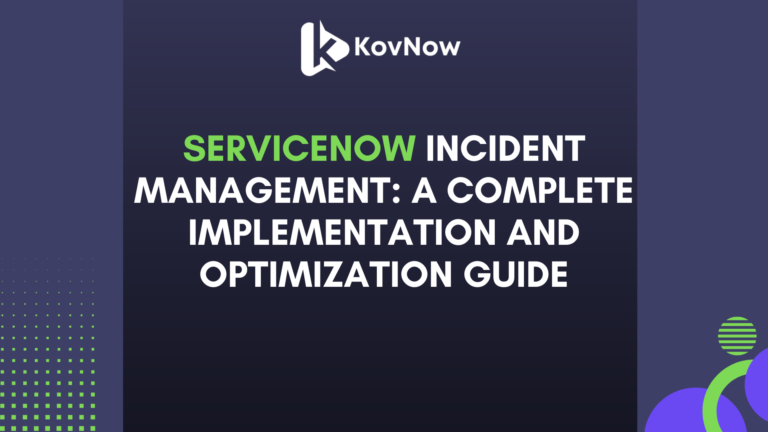For ServiceNow consulting firms, the true power of the platform often lies in its ability to seamlessly integrate with a myriad of other enterprise systems. From CRM and ERP to HRIS and monitoring tools, effective integrations are crucial for unlocking automation, gaining holistic visibility, and driving significant business value for clients. However, navigating the complexities of ServiceNow integration best practices can be challenging. Poorly executed integrations can lead to data silos, performance bottlenecks, and ultimately, project failure. At KovNow, we understand the critical importance of seamless data flow. We specialize in providing leading consulting firms with rapid access to rigorously vetted ServiceNow professionals with deep expertise in integration strategies, ensuring your clients achieve optimal enterprise performance. This post delves into the essential ServiceNow integration best practices that your team needs to master.
The Critical Role of Seamless Data Flow in ServiceNow Implementations
In today’s interconnected digital landscape, data is the lifeblood of business operations. ServiceNow, as a central platform for service management and digital workflows, must effectively communicate with other critical systems to provide a unified view and drive automation across the enterprise. The need for robust ServiceNow integration best practices stems from several key factors:
- Eliminating Data Silos: Integrating ServiceNow with other systems breaks down data silos, providing a comprehensive and consistent view of information across different departments and processes.
- Automating End-to-End Workflows: Seamless integrations enable the automation of complex, cross-functional workflows, reducing manual effort, improving efficiency, and minimizing errors.
- Enhancing Data Accuracy and Consistency: By establishing reliable data exchange mechanisms, integrations ensure data accuracy and consistency across disparate systems, leading to better decision-making.
- Improving Visibility and Reporting: Integrated data provides a holistic view of key metrics and performance indicators, enabling more insightful reporting and analysis.
- Driving Better Customer and Employee Experiences: By connecting relevant data across systems, organizations can deliver more personalized and efficient experiences for both customers and employees.
However, achieving seamless data flow requires a strategic and well-executed approach, adhering to established ServiceNow integration best practices.
Essential ServiceNow Integration Best Practices for Consulting Firms
To ensure successful and robust ServiceNow integrations for your clients, your consulting teams should adhere to the following key ServiceNow integration best practices:
1. Define Clear Integration Requirements and Objectives
Before embarking on any integration, it’s crucial to have a clear understanding of the business needs, data requirements, and desired outcomes. This involves:
- Identifying the Integration Purpose: Clearly define why the integration is needed and what business problem it aims to solve.
- Defining Data Mapping and Transformation Rules: Meticulously map the data fields between ServiceNow and the target system, outlining any necessary transformations or cleansing rules.
- Establishing Integration Frequency and Timing: Determine how often data needs to be exchanged and any specific timing requirements.
- Identifying Key Performance Indicators (KPIs): Define metrics to measure the success and effectiveness of the integration.
- Documenting Requirements Thoroughly: Comprehensive documentation ensures clarity, facilitates communication, and serves as a reference point throughout the integration lifecycle.
2. Choose the Right Integration Method
ServiceNow offers various integration methods, each with its own strengths and weaknesses. Selecting the most appropriate method is crucial for performance, scalability, and maintainability:
- REST APIs: A widely used standard for web-based integrations, offering flexibility and ease of use for real-time or near real-time data exchange.
- SOAP APIs: Another web service protocol, often used for integrations with legacy systems or applications that require more formal message structures.
- JDBC (Java Database Connectivity): Allows direct database-to-database integration, suitable for batch processing or scenarios where API access is limited.
- MID Server (Management, Instrumentation, and Discovery Server): A secure communication channel that facilitates integrations with on-premise systems and external services.
- Integration Hub: ServiceNow’s iPaaS (Integration Platform as a Service) offering pre-built spokes and connectors for various applications, simplifying and accelerating integration development.
- Email Integration: Suitable for less critical or asynchronous data exchange.
- File-Based Integration (SFTP, etc.): Useful for batch processing of large datasets.
The choice of integration method should be based on factors such as data volume, frequency, real-time requirements, security considerations, and the capabilities of the target system.
3. Prioritize Security and Data Governance
Security and data integrity are paramount in any integration. Adhering to robust security and data governance practices is essential:
- Secure Authentication and Authorization: Implement secure authentication mechanisms (e.g., OAuth 2.0) and enforce proper authorization controls to protect data access.
- Data Encryption: Encrypt sensitive data during transmission and at rest to prevent unauthorized access.
- Regular Security Audits: Conduct regular security audits of integrations to identify and address potential vulnerabilities.
- Data Validation and Error Handling: Implement robust data validation rules and error handling mechanisms to ensure data integrity and prevent data corruption.
- Compliance with Data Privacy Regulations: Ensure integrations comply with relevant data privacy regulations (e.g., GDPR, CCPA).
- Principle of Least Privilege: Grant only the necessary permissions to integration users and processes.
4. Design for Scalability and Performance
As data volumes and integration frequency grow, the integration architecture must be able to scale effectively without impacting performance. Consider the following:
- Asynchronous Processing: For non-real-time integrations, leverage asynchronous processing to avoid blocking ServiceNow processes.
- Batch Processing for Large Datasets: For large volumes of data, consider batch processing during off-peak hours.
- Efficient Data Queries: Optimize data queries to minimize the load on both ServiceNow and the target system.
- Connection Pooling: Utilize connection pooling to reuse connections and reduce overhead.
- Monitoring and Performance Tuning: Implement robust monitoring to track integration performance and identify areas for optimization.
5. Implement Robust Error Handling and Logging
Integrations are complex and prone to errors. Implementing comprehensive error handling and logging mechanisms is crucial for troubleshooting and maintaining stability:
- Centralized Logging: Implement centralized logging to track integration activity, errors, and performance metrics.
- Detailed Error Messages: Provide clear and informative error messages to facilitate troubleshooting.
- Alerting and Notifications: Set up alerts for critical integration failures to enable prompt intervention.
- Retry Mechanisms: Implement intelligent retry mechanisms for transient errors.
- Version Control for Integration Components: Maintain version control for scripts, configurations, and other integration artifacts.
6. Embrace Automation and Orchestration
Leveraging ServiceNow’s workflow automation and orchestration capabilities can significantly streamline and enhance integrations:
- Integration Hub Workflows: Utilize Integration Hub workflows to orchestrate complex integration processes without extensive coding.
- Flow Designer: Leverage Flow Designer to build automated integration flows using a visual, low-code interface.
- Scheduled Jobs: Automate recurring data synchronization tasks using scheduled jobs.
- Event-Driven Integrations: Trigger integrations based on specific events within ServiceNow or external systems.
7. Prioritize Maintainability and Reusability
Designing integrations with maintainability and reusability in mind reduces long-term costs and complexity:
- Modular Design: Break down complex integrations into smaller, reusable components.
- Clear Naming Conventions: Adhere to consistent and descriptive naming conventions for scripts, variables, and other integration elements.
- Comprehensive Documentation: Maintain up-to-date documentation for all integration components, including design specifications, data mappings, and error handling procedures.
- Configuration-Driven Approach: Favor configuration over hardcoding where possible to enhance flexibility and maintainability.
8. Thorough Testing and Validation
Rigorous testing is essential to ensure the reliability and accuracy of integrations:
- Unit Testing: Test individual integration components in isolation.
- Integration Testing: Test the end-to-end flow of data between ServiceNow and the target system.
- User Acceptance Testing (UAT): Involve end-users in testing to ensure the integration meets their business requirements.
- Performance Testing: Test the integration under realistic load conditions to identify potential performance bottlenecks.
- Regression Testing: Perform regression testing after any changes or upgrades to ensure existing integrations remain functional.
External Link: ServiceNow’s Developer Portal provides extensive resources and best practices for integration development: https://developer.servicenow.com/devportal.do
Internal Link: Consider linking to a blog post on choosing the right ServiceNow integration method for different scenarios.
KovNow’s Expertise in Delivering Seamless ServiceNow Integrations
At KovNow, we understand that successful ServiceNow implementations hinge on the ability to create seamless and robust integrations that drive tangible business value for your clients. Our global network of rigorously vetted ServiceNow professionals includes a deep pool of experts with extensive experience in designing, developing, and implementing complex integrations across various systems and using diverse integration methods.
Our approach to providing top-tier ServiceNow integration talent includes:
- Deep Technical Expertise: We thoroughly vet candidates for their proficiency in REST and SOAP APIs, JDBC, MID Server configuration, Integration Hub, and other integration technologies.
- Understanding of Integration Best Practices: We ensure our talent possesses a strong understanding of security protocols, data governance principles, performance optimization techniques, and error handling strategies.
- Experience with Diverse Integration Scenarios: Our network includes professionals with experience integrating ServiceNow with a wide range of enterprise applications.
- Focus on Business Outcomes: We provide talent that understands how integrations contribute to overall business objectives and can align technical solutions with strategic goals.
- Rapid Access to Specialized Skills: We can quickly connect you with integration specialists who have the specific skills and experience required for your clients’ unique integration needs.
Conclusion: Master ServiceNow Integrations for Enterprise Excellence with KovNow
Seamless data flow is the cornerstone of a successful ServiceNow implementation. By adhering to these ServiceNow integration best practices, your consulting firm can empower clients to break down data silos, automate critical workflows, and achieve true enterprise-wide efficiency. Partner with KovNow to access the rigorously vetted ServiceNow talent with the deep integration expertise needed to navigate complex integration scenarios and deliver exceptional value to your clients.
Ensure seamless data flow for your clients. Contact KovNow today to build your expert ServiceNow integration team: https://kovnow.com







